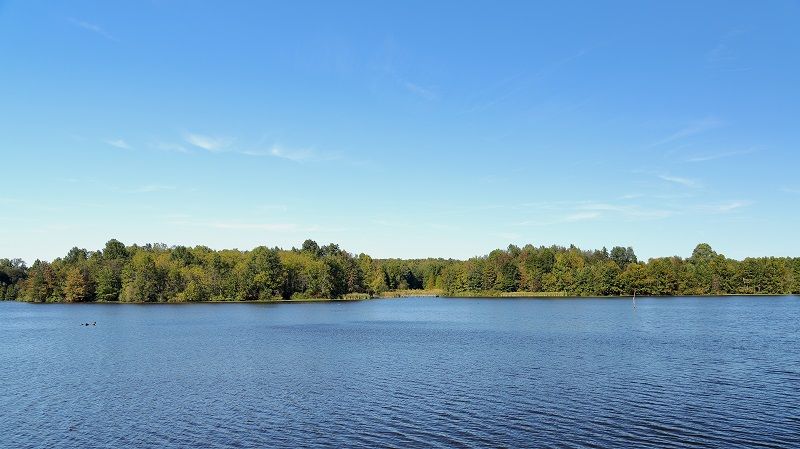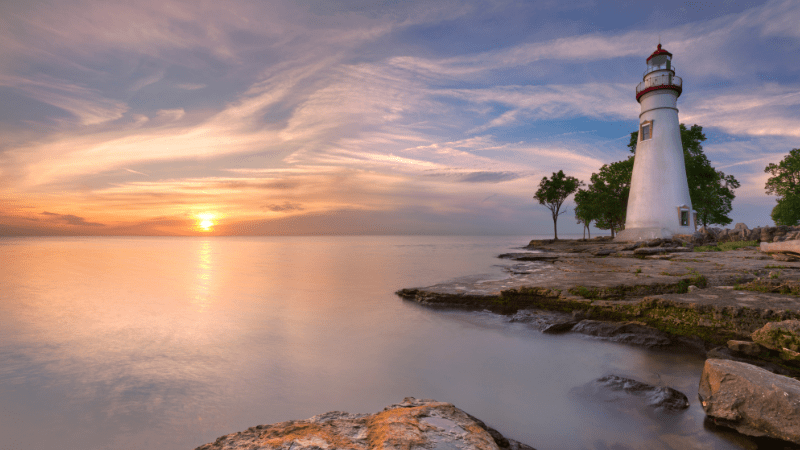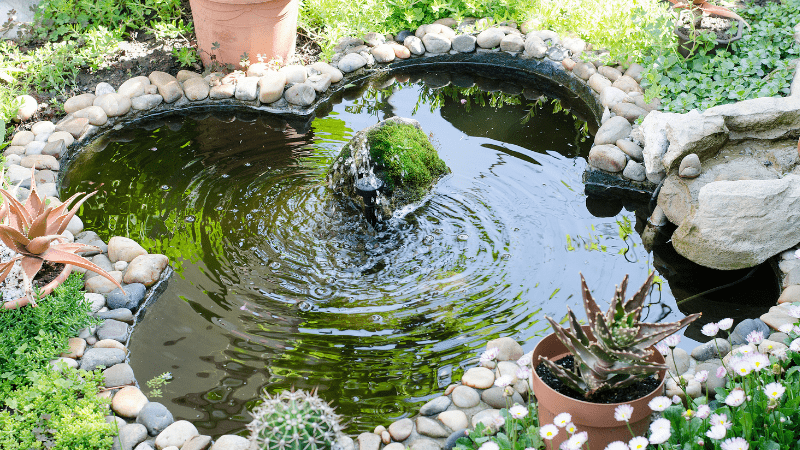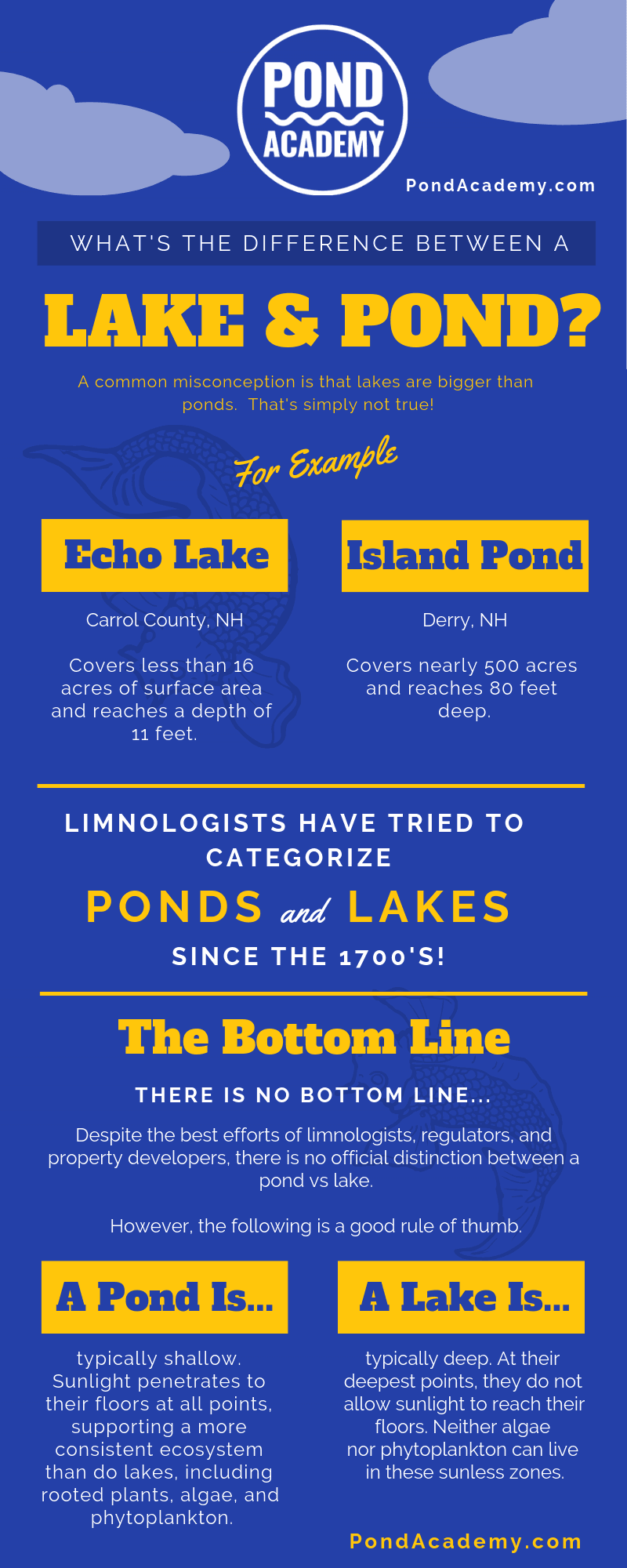Lake vs Pond: What Is the Difference Between a Lake and a Pond?
What is the difference between a pond and a lake?
Most people would say, "That's easy, a lake is bigger"!
Unfortunately, it's not that simple.
And, in this case, they'd undoubtedly be wrong since it's more than just surface area that distinguishes lakes from ponds.
So, let's get to the bottom of the pond vs. lake debate once and for all!

Lake vs Pond Definition
Let's start by taking a quick look at how a dictionary defines a lake and a pond. We'll refer to the famous Oxford Languages Dictionary.
Definition of a lake: a large body of water surrounded by land.
Definition of a pond: a small body of water formed naturally or by hollowing or embanking.
As you can see, even the most prestigious dictionary in the world fails to give any specific details on the difference between a lake and a pond. They simply infer that a lake is large and a pond is small (which isn't always true, as you'll discover below).
Get Our Best Pond Tips Sent to Your Inbox for Free!
Join thousands of others and learn from our decades of pond building and maintenance experience! Your pond will thank you!
By subscribing you agree to receive emails from PondAcademy.com. We will always respect your privacy and you can unsubscribe at any time.
How Do Regulatory Agencies Distinguish a Pond From a Lake?
In short, regulations and statutes don't help much, either.
For example, even a generously lake-strewn state like New Hampshire makes no distinction between lakes and ponds, either through its water-quality statutes (RSA 485-A) or its associated rules and regulations (Env-Wq 1700).
And as it happens, some ponds are larger than some lakes. You simply can't tell the difference at a quick glance.
Let's continue...
How do Limnologists Define a Lake and a Pond?
Limnology is the study of inland waters. Limnologists divide surface waters like lakes, ponds, and rivers into two broad categories: lotic waters, which flow in a continuous, definite, identifiable direction, and lentic waters, which do not.
Lentic waters may start as mere puddles but can grow to become lakes, ponds, or wetlands. This growth occurs so slowly that it is difficult to define the transition from one type of lentic water to another.
Not that limnologists haven't tried.
![]() Did you know...
Did you know...
Limnologists have tried to categorize ponds and lakes since the 1700s!
Pioneers of the discipline working in the late 1700s tried various approaches to classifying lentic waters. Most used area or depth to draw the line between lakes and ponds, but even those simple measurements were fraught. Some early limnologists looked further, using thermal stratification to distinguish a lake from a pond. In temperate climates, lakes were defined as bodies of water displaying several distinct temperature zones during warm summer months.
Other limnologists measured the aquatic life, particularly the plant growth, sustained by a body of water. Under some criteria, a pond was a body of standing water shallow enough to allow light to penetrate to its bottom surface and to sustain plant life there. Others defined a pond as a body of water capable of sustaining emergent pond plants across its entire surface. These days, we'd likely use "wetlands" to describe such an environment, underscoring the difficulty of categorizing nature.
Today's limnologists tend to start with the acknowledgment that we will never have a system of precise definitions for lakes, ponds, and wetlands. Instead, they focus on the differences between deep bodies of standing water and shallow ones.
A deep lake or pond is surrounded by a shallow shoreline region capable of supporting rooted plant growth (if the soil allows) and representing a distinct biological zone. Its floor descends to produce an area deep enough to prevent sunlight from reaching the bottom. In temperate climates, the large swings in ambient temperature produce distinct thermal layers, especially in warmer months.
A shallow lake or pond allows sunlight to penetrate to the entire floor, allowing for rooted plant and vegetation growth throughout the entire body of water (soil and other factors notwithstanding). Shallow bodies of water tend not to create thermal strata, however much their environments may change with the seasons, and support significantly different ranges of aquatic life than deep bodies.
So, now we're getting somewhere!
One distinguishing factor between lakes and ponds, by certain limnologists at least, is their depth. Deeper bodies of water create different, more complex environments for aquatic life than shallow ones.
Now, with that said, there are even exceptions to that rule... sigh.
Why Are Some Bodies of Water Called Ponds and Others Called Lakes?
In short, because someone picked a term, and others followed suit. "Lake" and "pond" no longer pretend to refer to any scientifically supported classification system or naming convention.
Common sense does play a part: lakes are usually larger and/or deeper than ponds. But many ponds are both larger in surface area than some lakes and deeper.
Referring back to New Hampshire, Echo Lake in Carroll County is the centerpiece of a popular state park, where visitors swim and fish for perch. It covers less than 16 acres of surface area and reaches a depth of 11 feet. Island Pond, near Derry, covers nearly 500 acres and reaches 80 feet deep: while "merely" a pond, it supports a much wider range of fish, including several bass species.

This seeming confusion of terms sometimes speaks to changes in the landscape. Island Pond was named before 1874, when a dam raised its level along with that of a neighboring pond, joining them to form a much larger body of water.
More often, ponds are renamed as lakes in the hopes of promoting them as residential or tourist destinations or just as a matter of local pride. Mud Pond, Mosquito Pond, and Dishwater Pond are now Mirror Lake, Crystal Lake, and (another) Mirror Lake.
In Summary: Difference Between a Lake and a Pond
So, what is the difference between a lake and a pond? Despite the best efforts of limnologists, regulators, and property developers, there is no official distinction between a pond vs. a lake.
But there is a common understanding when differing between freshwater lakes and ponds, and since most of us spend most of our time speaking in layman's terms, the following is a good rule of thumb.
What is a Lake?

Lakes are typically deeper than ponds. At their deepest points, they do not allow sunlight to reach their floors. Neither algae nor phytoplankton can live in these sunless zones, making for a distinctive ecosystem populated exclusively by carnivorous organisms. In temperate zones, lakes feature two or three thermal strata during the summertime months.
What is a Pond?

Ponds are typically shallow. Sunlight penetrates to their floors at all points, supporting a more consistent ecosystem than do lakes, including rooted plants and pond weeds, algae, and phytoplankton. Regardless of the surrounding climate, they feature only one thermal zone, though the character of that zone may change with the seasons.
Of course, there are exceptions to these rules of thumb. But, this is the best we got at this time.
Now, about brooks, creeks, and streams….
Lake Vs Pond Infographic





